Jul 25, 2018
Together We Can Be Bully Free: CAH and Law Enforcement Address Peer Victimization through School-Based Program
by Jenn Lukens
Nationally, one-fifth of students ages 12 to 18 reported being bullied at school in 2015. In rural Union Parish, Louisiana, the rate is arguably higher. Claudia Wade, program director for youth-focused intervention programs at Union General Hospital explains why: "People in rural areas are living in poverty more than in urban areas, and poverty is a risk factor for all sorts of health problems, including depression and teen suicide. So we have a lot of bullying going on, and most of the kids suffer in silence."
Since the early 2000s, researchers have studied the connection between bullying and the mental and physical effects on both perpetrator and victim. With rising concern regarding suicides, school shootings, and cyberbullying in recent years, schools and healthcare systems have sought to be proactive by establishing anti-bullying programs.
What is Bullying?
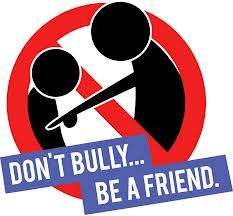 When Tony Cain accepted the executive
director position at Downsville Community Charter School
several years ago, he noticed a hypersensitivity around
bullying, also known as peer victimization. He addressed
the issue by helping parents, staff, and students
identify what bullying is and what bullying is not. "Just
because kids have a negative interaction does not
necessarily mean that it's bullying…sometimes kids just
bump into each other and get into a tiff. They're not
looking to disempower the other," explained Cain. "Our
role is to teach them what's appropriate and what's not."
When Tony Cain accepted the executive
director position at Downsville Community Charter School
several years ago, he noticed a hypersensitivity around
bullying, also known as peer victimization. He addressed
the issue by helping parents, staff, and students
identify what bullying is and what bullying is not. "Just
because kids have a negative interaction does not
necessarily mean that it's bullying…sometimes kids just
bump into each other and get into a tiff. They're not
looking to disempower the other," explained Cain. "Our
role is to teach them what's appropriate and what's not."
The National Center for Injury Prevention and Control defines bullying as "unwanted, aggressive behavior among school-aged children that involves a real or perceived power imbalance. The behavior is repeated, or has the potential to be repeated, over time." Bullying actions include threats, physical or verbal attacks, exclusion, and the spreading of rumors in-person or through social media.
Downsville Community Charter partners with one of Union General Hospital's programs, Together We Can Be Bully Free, to bring anti-bullying educational sessions to the classroom. Trainings take place during gym class for middle and high school students once a week over a 10-week period.
Cain supports research-based approaches, so he quickly became an advocate of the program. "The feedback that I get from my teachers is that the kids are engaged. If the kids are really engaged and apply what they are talking about to their own lives, then I think that's what makes it useful."
Taking a Direct Approach
Together We Can Be Bully Free was a result of a 2014 Community Health Needs Assessment survey distributed to rural residents across Union Parish. A common theme in the survey responses was the pressing need for behavioral health intervention. With a ratio of 1,320 patients to one mental health professional, the parish falls far behind the state average of 420 to one.
At the time of the assessment, the parish's sheriff department was receiving a high volume of bullying reports, and the hospital was treating nine teen suicide attempts per month. In 2014 alone, 12 youths died by suicide in Union Parish, one of whom was a fifth-grade victim of bullying. In response, Claudia Wade asked permission from the hospital administrators to jump-start the Together We Can Be Bully Free program. The program is now in elementary, middle, and high schools across the parish.
Wade, who grew up in El Salvador, applies much of what she learned working in international development and the Peace Corps to the six Union Parish General Hospital programs she manages, three of which are geared toward youth. For a successful training like this, Wade said that getting the right people to deliver the message is essential. Sherry Banks, a certified psychiatric nurse and professional counselor at Union General Hospital, works with Wade to plan and teach the program's sessions, along with Detective Cade Nolan.
Nolan, who is also the director of Crime Stoppers of Union Parish, takes a direct approach in his presentation style. "We were in agreement that, for the younger people to understand the effects of suicide and what to look for, you have to talk to them like adults and not like they're kids anymore," said Nolan. With up to 400 high school students in one room for each session, Nolan shares the Louisiana law that states bullying and cyberbullying are punishable crimes and that students as young as 10 years old can be arrested if caught.
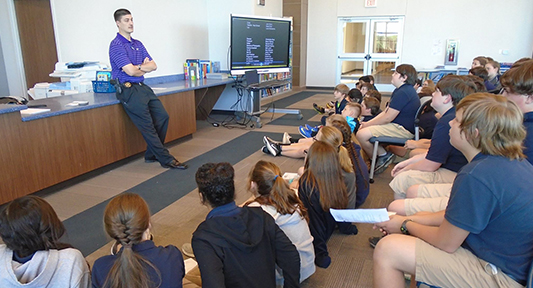
During her portion, Banks explains the different types of bullying, the reasons behind them, and their effects on both the victim and the bully. She engages students through role-play and videos that feature students who talk about their own experiences with bullying.
If a child has self-esteem issues, they may not develop into the confident adult that allows them to competently cope and handle bullies in the workplace.
An important part of the training is teaching victims of bullying to form an action plan. Strategies include not reacting to name-calling, staying in groups to limit bullying opportunities, and reporting bullying incidents. Building one's own self-esteem is also crucial. "If a child has self-esteem issues, they may not develop into the confident adult that allows them to competently cope and handle bullies in the workplace," said Banks. "Skills taught as a child certainly are worth the time to prevent an escalation into adulthood."
The curriculum the team created is based on their collective expertise and a variety of evidence-based practices. The material is subject to change based on the age group and the school's needs, and information is sent home with each student in hopes that parents will engage with their child about what they learned.
Together We Can Be Bully Free uses this 22-minute video as part of their curriculum to teach students about cyberbullying:
Being Available for Follow-Up
As Senior Investigator with Union Parish's Sheriff's Office, Nolan makes himself approachable to students, giving out his phone number and inviting students to message him on Facebook if they ever need anything. "I'm very careful when it comes to juveniles because I know the pressures they go through. I'm a little bit more open-minded when I talk to them, because I can tell the difference when something's being done out of meanness or because of personal issues," said Nolan.
I'm a little bit more open-minded when I talk to them, because I can tell the difference when something's being done out of meanness or because of personal issues.
While Crime Stoppers provides an anonymous tip line to report crime and bullying, one of the most successful ways Nolan and the other program coordinators get kids to open up is by staying around the school after a Together We Can Be Bully Free session. Students needing counseling, legal aid, medical attention, or psychological help are connected to school counselors, mental health specialists, the police, or child protection agencies. School administrators are pulled in to help address bullying situations between students.
At Downsville Community Charter, Cain handles bullying situations on a case-by-case basis, taking into consideration the child's background and home life. Being in a small community and school, he knows if consequences or action plans will be reinforced at home. "Some kids are bullies because they were raised to be bullies by their parents. So calling their parents is a waste of time. So we try to deal with it in school with counseling," said Cain.
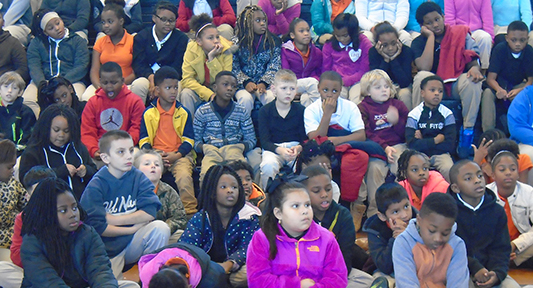
The Effects of Bullying
Multiple studies, including an article published in Children and Youth Services Review, found that youth who are bullied are more likely to experience higher rates of suicide, depression, substance abuse, violent behavior, and feelings of hopelessness. Often, these issues worsen with age. Suicidal tendencies and depression due to cyberbullying among females were reported at higher rates than among males.
At Downsville Community Charter, Cain's staff has noticed bullying trends differ among their students. For lower elementary students, it's name-calling, hair-pulling, and kicking. Girls ages 10 to 12 often use exclusion or intimidation. High school students more frequently engage in cyberbullying using social media.
"Kids bully kids that don't look just like them; they just do. And they are taught that from home, most of the time. It's sad," said Banks.
Much like adverse childhood experiences (ACEs), bullying has psychological and physical effects that can impact a child's ability to learn. Banks has learned that her patients' symptoms like tension headaches, bed wetting, eating disorders, and stomachaches can be signs of bullying. Effects can also show up later in life in the form of diabetes, long-term heart disease, and other physical and mental debilitations. The frequent release of the stress hormone, cortisol, in young victims of bullying is concerning to Banks.
If you stay in fear a lot, and you stay so anxious you are dreading going to school, and you are going to do whatever you can do to keep Mama from sending you to school – like throwing up – you are releasing a lot of stress hormone. And that can weaken your immune system where you can get sick, catch colds, and agitate allergies.
"If you stay in fear a lot, and you stay so anxious you are dreading going to school, and you are going to do whatever you can do to keep Mama from sending you to school – like throwing up – you are releasing a lot of stress hormone. And that can weaken your immune system where you can get sick, catch colds, and agitate allergies," said Banks.
Union General Hospital's healthcare providers are trained on how to conduct depression screenings and detect signs of bullying, suicidal tendencies, and other behavioral patterns. The wide variety of mental health outpatient services offered by the Critical Access Hospital can help patients cope with these and other issues.
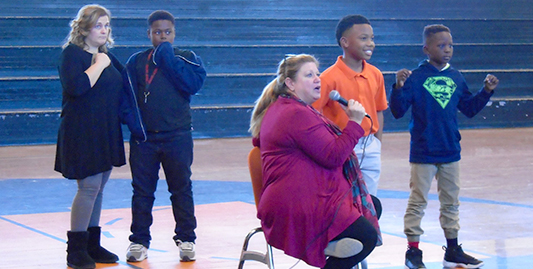
Reversing a Bully's Behavior
While anti-bullying efforts often focus on the victim, Banks emphasized that the true challenge is reaching the bully first: "Bullies don't get a fair shake – whether they need discipline or consequences, or maybe they are in a really bad situation and no one is there to help them; sometimes they have a mental illness that is being ignored. If I can get them some therapy, I know they can turn around. I've seen kids turn around."
Since most bullies target several children at a time, Banks argues that addressing the bully's behavior first can have a bigger impact on a greater number of people in the long run. During her presentation, Banks explains the reasons behind a bully's actions and follows it with an invitation for bullies to come forward in front of the entire group. At least one bully has stepped forward at every session.
"A common fact among convicted criminals is that they were bullies during middle school," she said. "But if I can catch a 10-year-old before he gets to that stage, and he comes forward, then there's usually more that follow his example. It usually speaks volumes to the kids of all ages."
At the end of one session, a twelve-year-old girl stepped forward. She was large for her age and was known to hit others. Through Together We Can Be Bully Free, she realized she was wrong and started seeing a counselor to change her behavior. A year later, she came forward during a session and shared her experience.
We are trying to teach them to see good from bad and, if you do something wrong, it's never too late to change things.
"We are trying to teach them to see good from bad and, if you do something wrong, it's never too late to change things," shared Wade.
Keeping Eyes Open to Make a Difference
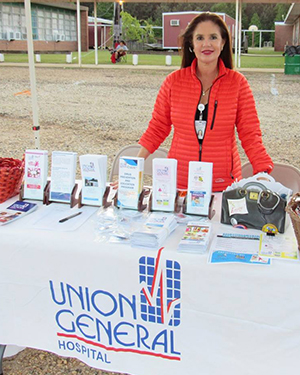
Since starting the Together We Can Be Bully Free program, school administrators have seen a decrease in bullying among their students. Calls to report bullying to Crime Stoppers have also slowed. In the last five years, the parish has seen zero suicides in youth under the age of 20.
Cain hears positive reports from teachers at Downsville Community Charter: "They are really engaged and ask all kinds of questions. They talk about things that are going on their own lives. To me, that indicates that this is being effective." Because of Together We Can Be Bully Free's influence, the school is implementing a comprehensive positive behavioral support program this year. The new method will include behavioral modification and rewards for anti-bullying behavior and proactive approaches.
One success story Wade proudly shared is Annabelle's (name changed for privacy). Because she was a victim of bullying, her family moved to Union Parish. "She was very traumatized, but thanks to the [Together We Can Be Bully Free] classes, her self-esteem improved. She also wrote a short book about how our classes helped her overcome her issues." One year, she ran a lemonade stand and donated her earnings to the program.
Another student whose mother was verbally abusive was helped by the Together We Can Be Bully Free program. She went on to graduate from Grambling State University. Other victims of bullying have learned to build up their self-esteem, applying themselves to the study of medicine, education, and other professions.
If we want to make a difference, we need to keep doing what we are doing. We cannot close our eyes to the problem that is there.
Other schools that have heard of the program's successes and its straightforward training style have contacted Wade for tips on how to start something similar. She tells them to be ready for rejection, denial that a bullying problem exists, and pushback about their direct approach, but to remain firm in their mission: "If we want to make a difference, we need to keep doing what we are doing. We cannot close our eyes to the problem that is there."
Additional Resources
- Stopbullying.gov, U.S. Department of Health and Human Services – Provides information and resources regarding bullying, cyberbullying, and preventing both in various settings.
- The Relationship Between Bullying and Suicide: What We Know and What it Means for Schools, CDC's National Center for Injury Prevention and Control and the Division of Violence Prevention – Includes bullying facts, action steps, federal resources, and journal articles.
- Overview: School Bullying, National Conference of State Legislators – Includes research and reports, school bullying links, and legislation briefs.
